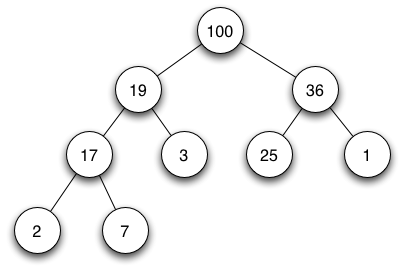CSC212 Lab 12 2014
--D. Thiebaut (talk) 19:37, 9 November 2014 (EST)
Contents
This lab deals with Sorting algorithms, HeapSort, QuickSort, and methods used to avoid worst-case conditions.
Lab Problem #1: Recursion-Stack Depth
- Create a class containing the code for Quicksort.
- Run it on arrays of size 10, 200, 500, 1000, 5000, 10000, 50000, 100000. Keep on increasing the size until something happens...
- You probably ran into an exception... Make sure you read what the exception is... Can you figure it out?
- Read the documentation of the -XSS command line on this page.
- Apply it to your program
- If you are using Eclipse, click on the Run top menu-option, then Run Configurations, then on the Arguments tab, and in the VM arguments window, enter something like -Xss64m (you'll have to do go through some trials and errors to find the right value.
- * If you are running your Java code on beowulf, simply add the option on the command line:
java -Xss64m QuickSort 1000000 random
- Make sure you have define a large enough stack to sort at least a million ints.
Lab Problem #2: HeapSort
- Java provides heap data structures, but calls them PriorityQueues.
- Instead of keeping the largest element at the top of the heap, PriorityQueues keep the smallest element at the top.
- Try the example below to see how to use a PriorityQueue
import java.util.PriorityQueue; public static void TestPrioQueues() { PriorityQueue<Integer> heap = new PriorityQueue<Integer>(); heap.add( 1 ); heap.add( 20 ); heap.add( 5 ); heap.add( 100 ); while ( ! heap.isEmpty() ) System.out.println( heap.poll() ); }
- Question 1
- Using some of the code/functions from this page, create a function called heapsort( int[] A ) that will use a priority queue to sort the array of ints A.
- Question 2
- Using the code snippet below, measure the execution times of QuickSort and of your HeapSort function. Figure out which is regularly faster on arrays of varying sizes.
long start = System.nanoTime(); quicksort(A, 0, A.length - 1); long end = System.nanoTime(); System.out.println( String.format( "quickSort( %d ) takes %1.3f msec", N, (end-start)/1000000.0f ) );
Lab Problem #3: Speeding Up QuickSort
- You should have gone through Problem #2 and modified QuickSort so that you can measure its execution time.
- Name your file Lab12_3.java, and your class Lab12_3 (you will need to submit it to Moodle).
- Run it on sorted arrays of varying sizes until you find an array size that requires between 1 and 10 seconds of execution time.
- Pick one of the methods we saw in class for allowing Quicksort to avoid worst case conditions, and implement it. Modify your code.
- Verify that you have seriously improved your Quicksort function with this mod.
Moodle Submission
- Submit your program to Moodle. Your program will be run against the solution program on a sorted array. The grade is proportional to how close your execution time comes to the execution time of the solution program.

